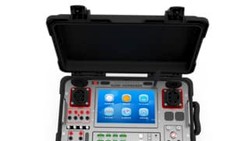In 2023, Smart Meter Integration will continue to evolve. The communication technologies are continuing to change, making it easier for both, customers and utilities to manage their energy use. As we move forward, there are a few things that we can expect. In the next years, we will see more widespread use of smart meters in residential and commercial buildings in all regions of the world, combined with advanced integration software.

Increasing Energy Demand due to Electric Vehicles
As the popularity of electric vehicles grows, so does the need for more efficient and sustainable methods of powering these vehicles. Why do we still accept the conversion losses for DC-charging while we could supply DC power direct from a local energy storage container? With more efficient use of smart meters and other sensor components, energy companies can improve their data accuracy by receiving real-time readings from the meters instead of relying on estimates. This is improving the planning security, forecast and efficiency.
Life-Style Transformation
The border between our personal and professional life will continue to shrink as we grow more connected. The technologies we use at home are to become networked with the ones we use at work. This pattern is already taking shape. In the after-COVID phase some companies are struggling to get their employees back from home-office. Smart home technology and autonomous power generation/storage will become more widely used in the next years.
One of the most significant changes affecting smart homes is a shift in the demographics of those who live in them. The number of people aged 65 and more is predicted to rise from 15 % in 2020 to 21 % by 2030. The Baby Boomer generation is reaching retirement age and will begin to downsize. This is noteworthy since this age group is more likely to require assistance with daily activities. In addition, they are much more likely to be on a limited income.
At the same time, there will be a growing number of single-person households. This will create a demand for smaller homes that are easier to maintain.
The Internet of Things (IoT)
The trend of the “Internet of Things” (IoT) is on the growth. More and more devices will be connected to the internet and to each other. This includes also energy meters and other metering devices. IoT will open up new opportunities for energy management service providers.
Software and Information Technologies for a Smarter Grid
The Smart Grid will be made up of controls, computers, automation, and new technologies and equipment working together, much like the Internet. However, unlike the Internet, these technologies will cooperate with the electrical grid to digitally adapt to our rapidly changing demand for electricity.
To make sure that the advantages we anticipate from the Smart Grid become a reality throughout the actual transition phase, it will be crucial to conduct out testing, technical advancements, consumer education, establishment of standards and laws, and information exchange amongst projects. The following are some advantages of the Smart Grid:
- more effective power transmission
- faster power restoration following power outages
- reducing operational and administrative expenses for utilities
- reducing peak demands
- enhanced customer-owner power generation system integration
- large scale integration of renewable energy
Since more and more data have to be processed, there will be a certain additional demand for specialists or companies, like system integrators, data-analysts and network security experts. With rapidly increasing utilization of solar- and wind-power, it's also required to have a more precise weather forecast together with related data storage to build up a history and to improve the capacity planning for the next 24 hours.
Takeaway
The world is still in the transition phase to large scale integrated smart grids. One additional challenge is the smooth integration of renewable energy sources together with energy storage technologies.
Please get in touch with us if you have any questions about what we can do to support the smart grid.
Editor's note: This article was originally published in January 2023 and has been updated for comprehensiveness.





Our main challenge is on the communication channels and modes which is still new technology not understood by many
Thank you for the valuable comment, Patricia. Supplier training for the utility staff is an important aspect for a smooth transition to smart grid.